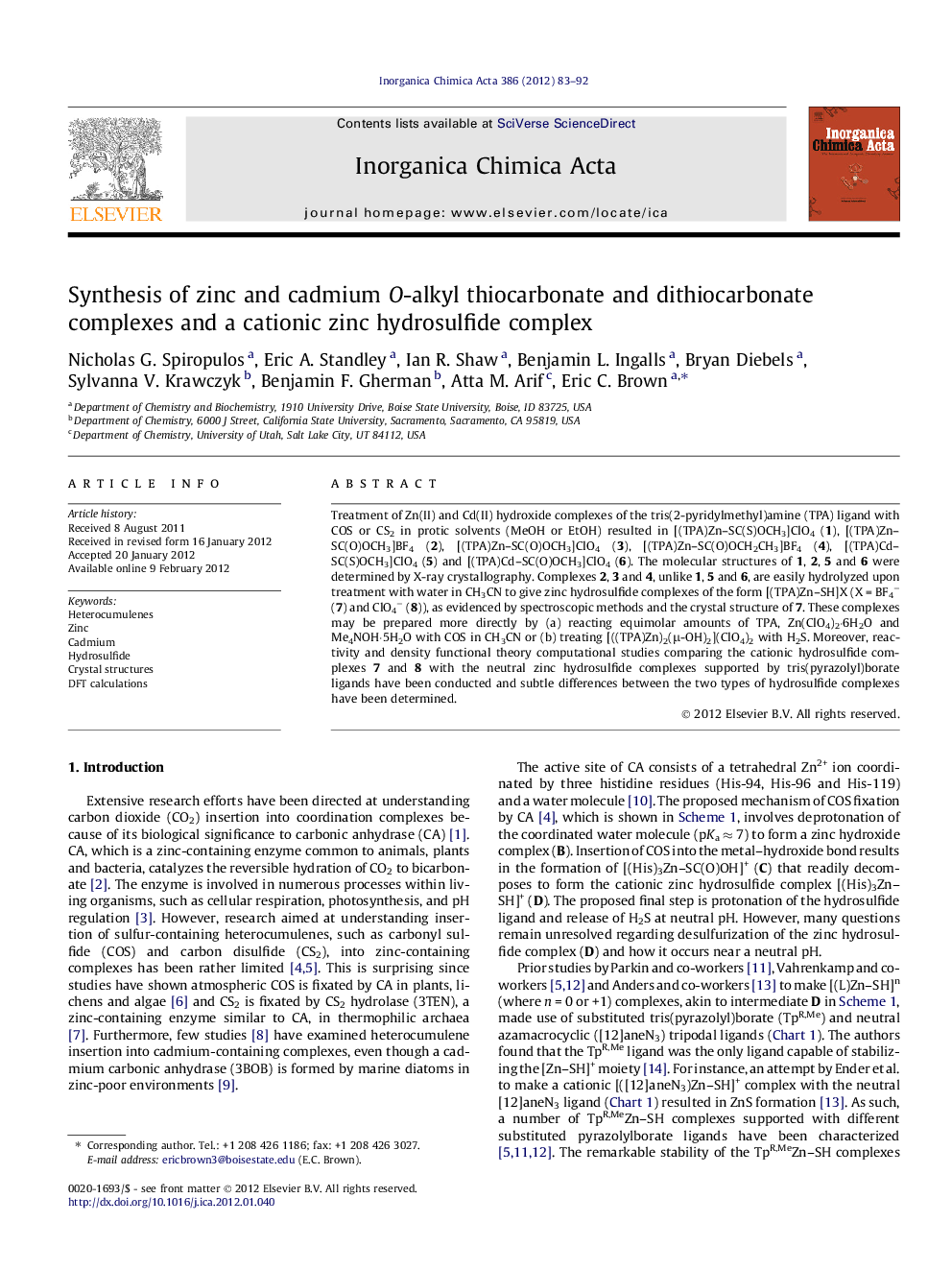| کد مقاله | کد نشریه | سال انتشار | مقاله انگلیسی | نسخه تمام متن |
|---|---|---|---|---|
| 1310985 | 1499201 | 2012 | 10 صفحه PDF | دانلود رایگان |

Treatment of Zn(II) and Cd(II) hydroxide complexes of the tris(2-pyridylmethyl)amine (TPA) ligand with COS or CS2 in protic solvents (MeOH or EtOH) resulted in [(TPA)Zn–SC(S)OCH3]ClO4 (1), [(TPA)Zn–SC(O)OCH3]BF4 (2), [(TPA)Zn–SC(O)OCH3]ClO4 (3), [(TPA)Zn–SC(O)OCH2CH3]BF4 (4), [(TPA)Cd–SC(S)OCH3]ClO4 (5) and [(TPA)Cd–SC(O)OCH3]ClO4 (6). The molecular structures of 1, 2, 5 and 6 were determined by X-ray crystallography. Complexes 2, 3 and 4, unlike 1, 5 and 6, are easily hydrolyzed upon treatment with water in CH3CN to give zinc hydrosulfide complexes of the form [(TPA)Zn–SH]X (X = BF4− (7) and ClO4− (8)), as evidenced by spectroscopic methods and the crystal structure of 7. These complexes may be prepared more directly by (a) reacting equimolar amounts of TPA, Zn(ClO4)2·6H2O and Me4NOH·5H2O with COS in CH3CN or (b) treating [((TPA)Zn)2(μ-OH)2](ClO4)2 with H2S. Moreover, reactivity and density functional theory computational studies comparing the cationic hydrosulfide complexes 7 and 8 with the neutral zinc hydrosulfide complexes supported by tris(pyrazolyl)borate ligands have been conducted and subtle differences between the two types of hydrosulfide complexes have been determined.
Zinc and cadmium complexes with O-alkyl thiocarbonate and dithiocarbonate ligands were prepared via reaction of COS or CS2 with [((TPA)M)2(μ-OH)2]2+ (where M = Zn, Cd and TPA = tris(2-pyridylmethyl)amine) in alcoholic solvents. The alkyl thiocarbonate zinc complexes are susceptible to hydrolysis and result in complexes of the general formula [(TPA)Zn–SH]X (X = BF4− or ClO4−). [(TPA)Zn–SH]BF4 was characterized by spectroscopic methods and X-ray crystallography. Several other routes for making [(TPA)Zn–SH]+ more directly from [((TPA)Zn)2(μ-OH)2]2+ are described. Furthermore, reactivity and computational studies comparing the cationic and neutral zinc hydrosulfide complexes [(TPA)Zn–SH]+ and TpZn–SH (Tp = tris(pyrazolyl)borate) were performed.Figure optionsDownload as PowerPoint slideHighlights
► Zn and Cd complexes with O-alkyl thiocarbonate and dithiocarbonate ligands were prepared.
► The first structurally characterized Zn and Cd complexes containing an M–SC(O)OR fragment were obtained.
► Zinc complexes with thiocarbonate ligands are hydrolyzed to [(TPA)Zn–SH]+ complexes.
► [(TPA)Zn–SH]BF4 was characterized by spectroscopic methods and X-ray crystallography.
► DFT calculations and reactivity studies show differences between [(TPA)Zn–SH]+ and TpZn–SH.
Journal: Inorganica Chimica Acta - Volume 386, 15 May 2012, Pages 83–92